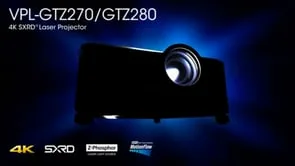LCOS has traditionally run a distant third to 3LCD and DLP based projector technology. But with the coming of High Dynamic Range TVs and content, interest in HDR projection solutions will grow. And right now, it looks like traditional transmissive 3LCD and reflective DLP are not up to the task, but LCOS is.
For example, if you look at the native contrast ratio of 3LCD or DLP projectors, they are typically in the 1000:1 to 2000:1 range. Yes, they can go much higher with a dynamic iris, but that does not work for a real HDR display. The wide contrast must be available on different parts of the display simultaneously which a dynamic iris, which widens and narrows based upon the content, does not allow.
HDR DLP projectors are now being deployed by Dolby and IMAX, but these depart from the conventional 3-chip prism block design to get to higher contrast. The Dolby solution, developed with Christie, features two 3-chp DLP engines in series to add a second modulation step. (Christie Demos High Dynamic Range Projector) The IMAX solution, developed with Barco, eliminates the prism design going to a more free-form 3-chip DLP architecture. Exact contrast numbers are not available but industry experts suggest it is in the 8000:1 range.
Dynamic contrast on a direct view LCD does meet the needs of HDR however, as small regions of the image can be adjusted in luminance level to expand the range between black and white, by adjusting the backlight.
While there is still no accepted definition of the contrast needed for an HDR display, something beyond of 5,000:1 seems like a minimum to most and LCOS can get there.
D-ILA LCOS projectors from JVC for example, can offer 30,000:1 native contrast without a dynamic iris. At Infocomm 2015, Sony showed a new SXRD LCOS 4K projector with 20,000:1 native contrast that will become available in January 2016. Rockwell Collins uses a SEOS projection design for its simulators that features a traditional 3-chip LCOS engine followed by a fourth LCOS panel that adds additional modulation for deep black levels. Epson has a high contrast home cinema projector as well, but it uses their reflective LCD technology.
While the Sony projector appears to be the first that will be optimized for HDR content, JVC can also show HDR content – which they did in the NAB and Infocomm booths. Expect the company to offer something to support its home theater projector business.
Analyst Comment
So, LCOS is in a great position to capture market share for HDR content when that starts to flow. Will other projector brands use the capabilities of LCOS to develop new HDR projection products? (CC)

